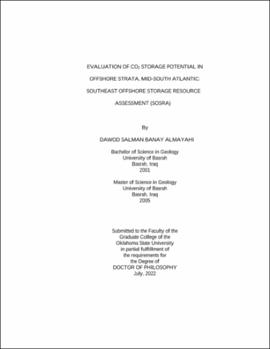| dc.contributor.advisor | Knapp, James | |
| dc.contributor.author | Almayahi, Dawod Salman Banay | |
| dc.date.accessioned | 2023-04-05T16:21:04Z | |
| dc.date.available | 2023-04-05T16:21:04Z | |
| dc.date.issued | 2022-07 | |
| dc.identifier.uri | https://hdl.handle.net/11244/337300 | |
| dc.description.abstract | Subsurface geological storage of CO2 has the potential to significantly offset greenhouse gas emissions for safe, economic, and acceptable public use of fossil fuels. Due to legal advantages and vast resource capacity, offshore CO2 storage provides an attractive alternative to onshore options. Although offshore Lower Cretaceous and Upper Jurassic reservoirs have a vast expected storage capacity, quantitative assessment of the offshore storage resource in the southeastern United States is limited. This work is a part of the Southeast Offshore Storage Resource Assessment (SOSRA) project, which presents quantitative evaluation of a high-quality potential geological repository for CO2 in the Mid- and South Atlantic Planning Areas. This is the first comprehensive investigation and quantitative assessment of CO2 storage potential for the outer continental shelf within the Lower Cretaceous and Upper Jurassic rocks, including the Southeast Georgia Embayment and most of the Blake Plateau. An interpretation of 200,000 km of legacy industrial 2D seismic reflection profiles and geophysical well logs (TRANSCO 1005-1, COST GE-1, and EXXON 564-1) are utilized to create structure and thickness maps for the potential reservoirs and seals. Three target reservoirs isolated by seals based on their effective porosity values are identified and assessed. A quantitative evaluation of CO2 Storage Potential in the Offshore Atlantic Lower Cretaceous and Upper Jurassic Strata is calculated using the DOE-NETL equation for saline formations. The prospective storage resources evaluation ranges between 450 and 4700 Mt of CO2 within the Lower Cretaceous and between 500 and 5710 Mt within the Upper Jurassic sandstone rocks at P10 to P90. The efficiency factor of the dolomite ranges from 0.64 to 5.36 percent at P10 to P90 for the formation scale. Facies classification of five offshore wells in the Southeast Georgia Embayment was applied to the Machine Learning approach using Support Vector Classifier (SVC) and Random Forest Classifier (RFC). As a result, the SVC and RFC algorithms were compared to evaluate facies classification accuracy; the RFC had the most accurate and effectively used outcomes to classify lithofacies. The Machine Learning approach resulted in reliable and accurate values of predicted facies classification to improve CO2 storage estimation. | |
| dc.format | application/pdf | |
| dc.language | en_US | |
| dc.rights | Copyright is held by the author who has granted the Oklahoma State University Library the non-exclusive right to share this material in its institutional repository. Contact Digital Library Services at lib-dls@okstate.edu or 405-744-9161 for the permission policy on the use, reproduction or distribution of this material. | |
| dc.title | Evaluation of CO2 storage potential in offshore strata, mid-south Atlantic: Southeast Offshore Storage Resource Assessment (SOSRA) | |
| dc.contributor.committeeMember | Knapp, Camelia | |
| dc.contributor.committeeMember | Pashin, Jack Charles | |
| dc.contributor.committeeMember | Bikkina, Prem | |
| osu.filename | almayahi_okstate_0664d_17858.pdf | |
| osu.accesstype | Open Access | |
| dc.type.genre | Dissertation | |
| dc.type.material | Text | |
| thesis.degree.discipline | Geology | |
| thesis.degree.grantor | Oklahoma State University | |
